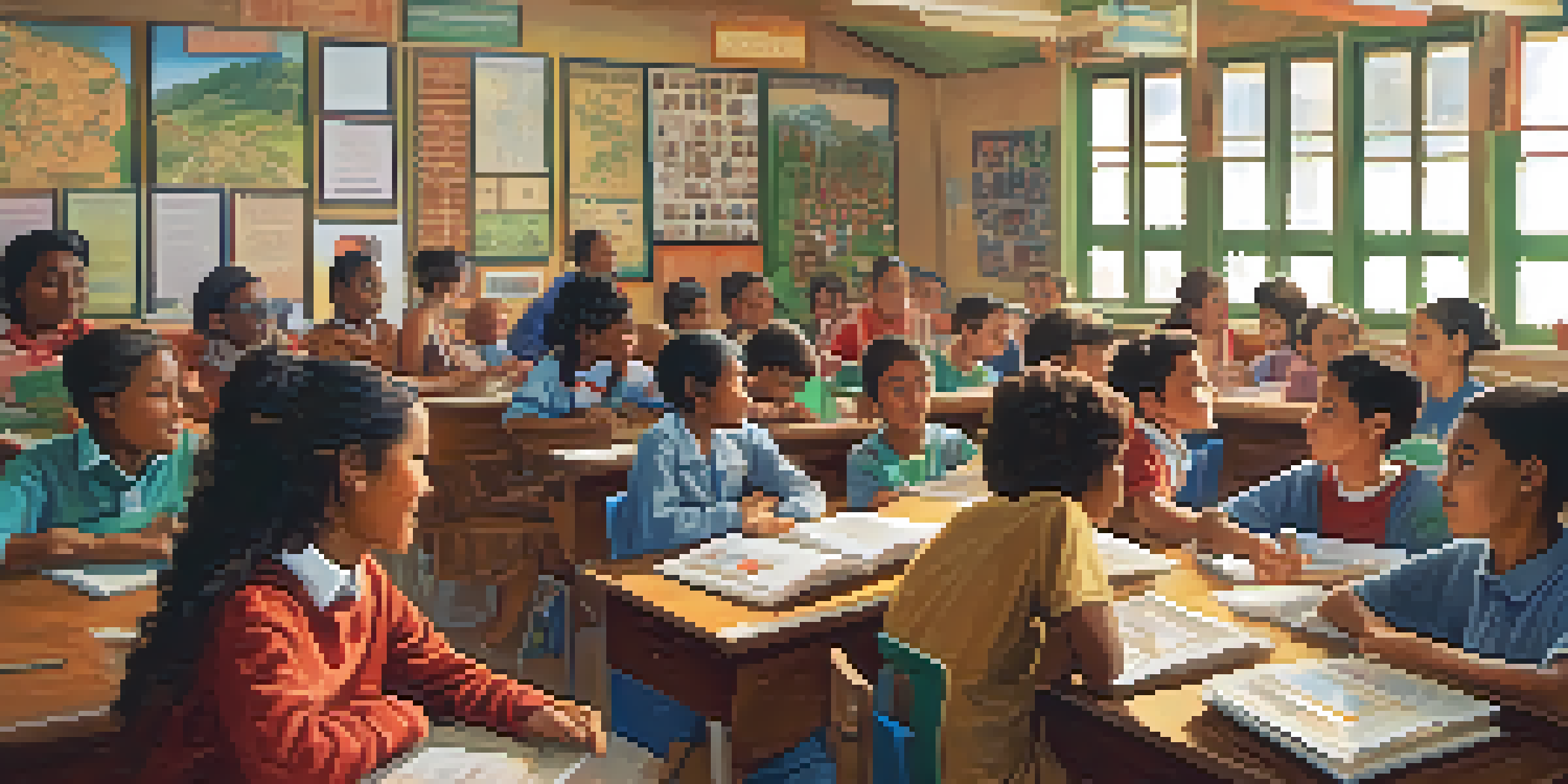The Benefits of Multicultural Education in Global Learning

Understanding Multicultural Education: A Definition
Multicultural education is an approach that recognizes and celebrates the diverse backgrounds of students. It emphasizes inclusion and values various cultural perspectives in the learning environment. By integrating different cultures into the curriculum, educators can foster a sense of belonging and respect among students.
Education is the most powerful weapon which you can use to change the world.
This approach not only enriches the educational experience but also prepares students to thrive in a globalized world. Imagine a classroom where stories from various cultures are shared, allowing students to connect with each other's heritage. This shared understanding can pave the way for better communication and collaboration.
Ultimately, multicultural education lays the groundwork for a more inclusive society. It encourages students to appreciate diversity, promoting empathy and reducing prejudice as they learn about different ways of life.
Cultural Awareness: Bridging Gaps Through Education
One of the primary benefits of multicultural education is the promotion of cultural awareness. When students learn about different cultures, they begin to understand and appreciate the values and traditions of others. This awareness helps dismantle stereotypes and fosters a sense of respect.

For instance, a lesson that includes a discussion on global festivals allows students to see the beauty in diversity. They might discover that different cultures celebrate similar themes of love, family, and community, despite their varied customs. This realization can create connections that transcend borders.
Embracing Diversity in Education
Multicultural education fosters inclusion and appreciation of diverse cultural perspectives, preparing students for a globalized world.
As students engage with diverse perspectives, they become more open-minded and adaptable. This adaptability is crucial in a world where collaboration across cultures is increasingly necessary.
Enhancing Critical Thinking Through Diverse Perspectives
Multicultural education encourages critical thinking by exposing students to various viewpoints. When learners encounter diverse opinions and practices, they are challenged to think critically about their own beliefs and assumptions. This process can lead to deeper understanding and personal growth.
In diversity there is beauty and there is strength.
Consider a debate in class on a global issue where students represent different cultural viewpoints. Such an exercise not only sharpens their analytical skills but also nurtures their ability to empathize with others. They learn to respect differing opinions while articulating their own.
Cultivating critical thinking in this manner prepares students for real-world challenges. In an interconnected world, the ability to navigate complex issues with a balanced perspective is invaluable.
Fostering Empathy and Emotional Intelligence in Students
Multicultural education plays a vital role in developing empathy among students. By learning about the experiences and struggles of others, students can better understand emotions and perspectives that differ from their own. This emotional intelligence is crucial in building strong interpersonal relationships.
Imagine a student who learns about the hardships faced by refugees. This knowledge can inspire compassion and motivate them to take action, whether through volunteering or advocating for change. Such experiences can transform students into active, empathetic citizens.
Building Empathy and Understanding
Through learning about different cultures, students develop empathy and emotional intelligence, essential for strong interpersonal relationships.
Ultimately, fostering empathy through education helps create a more harmonious society. Students who understand and respect each other are more likely to collaborate and work toward common goals.
Preparing Students for a Global Workforce
In today’s global economy, multicultural education equips students with essential skills for the workforce. Employers increasingly seek individuals who can navigate diverse work environments and engage with colleagues from various backgrounds. Understanding cultural nuances can give students a competitive edge.
For example, a student who has learned about international business practices is better prepared for a career that involves global teamwork. They are more likely to communicate effectively and appreciate different perspectives in a professional setting. This adaptability is crucial in a rapidly changing job market.
By integrating multicultural education into the curriculum, schools can help students become valuable assets in the workforce. This preparation not only benefits individuals but also enhances organizational culture and effectiveness.
Building Stronger Communities Through Education
Multicultural education extends beyond the classroom; it has the power to strengthen communities. When students learn to appreciate diversity, they become advocates for inclusion and social justice within their neighborhoods. This advocacy can lead to collaborative community initiatives and increased civic engagement.
For instance, students might organize cultural events that celebrate their diverse backgrounds, fostering unity and understanding among residents. These events can serve as platforms for dialogue, allowing community members to share their stories and experiences.
Preparing for a Global Workforce
Multicultural education equips students with vital skills to thrive in diverse work environments, enhancing their competitiveness in the job market.
In turn, stronger communities are built on the foundation of mutual respect and collaboration. As students carry these lessons into their lives, they help create environments where everyone feels valued and heard.
Challenges and Solutions in Implementing Multicultural Education
While the benefits of multicultural education are clear, challenges can arise in its implementation. Some educators may lack the resources or training to effectively integrate diverse perspectives into their teaching. Additionally, there may be resistance from parents or community members who are unfamiliar with the concept.
However, these challenges can be addressed through professional development and community engagement. Providing teachers with workshops and resources can empower them to create inclusive curricula. Engaging parents in discussions about the value of multicultural education can also foster support and collaboration.

Ultimately, overcoming these challenges is essential for maximizing the benefits of multicultural education. By working together, educators, parents, and communities can create enriching learning environments that celebrate diversity.